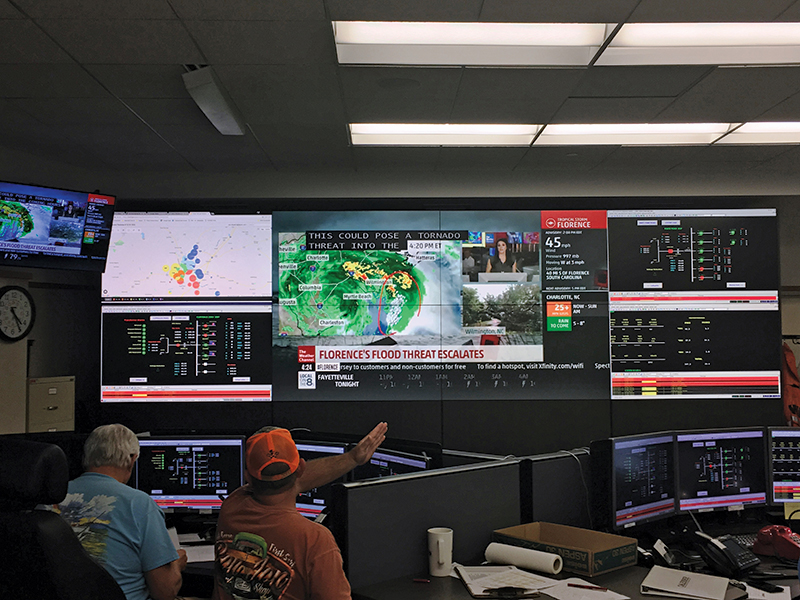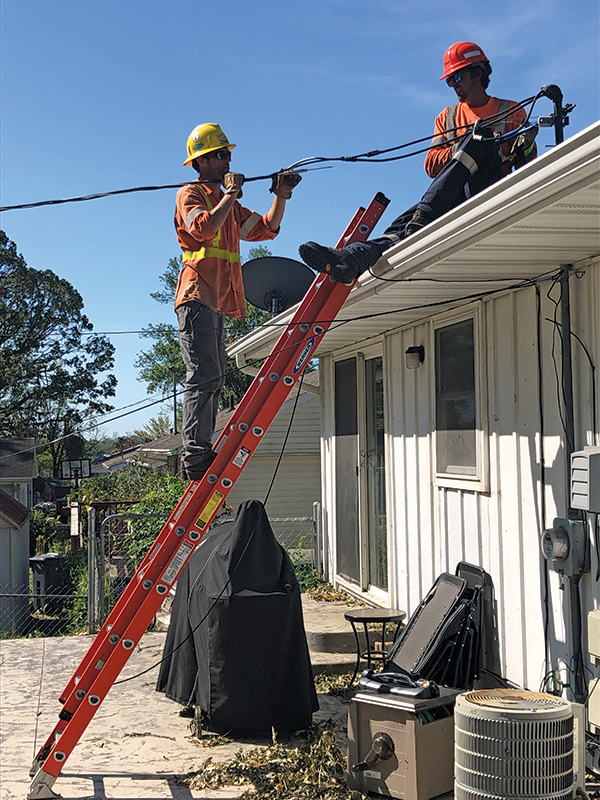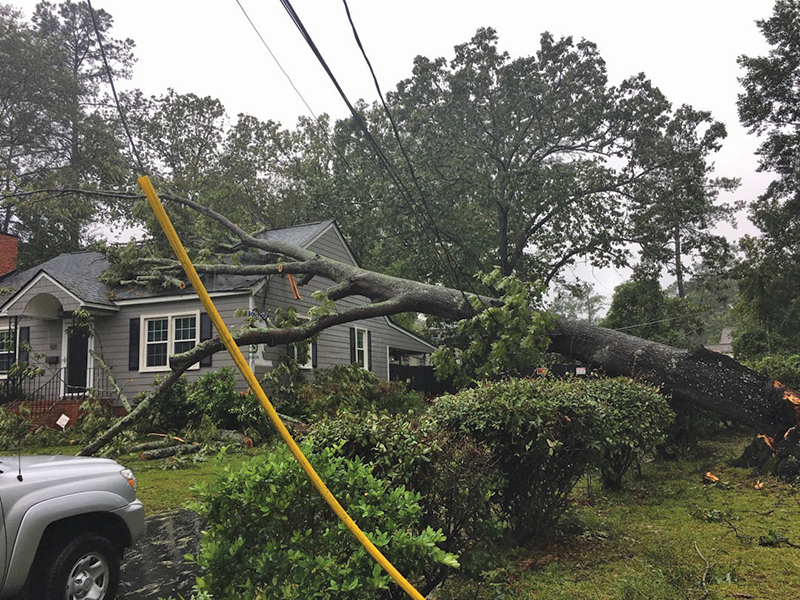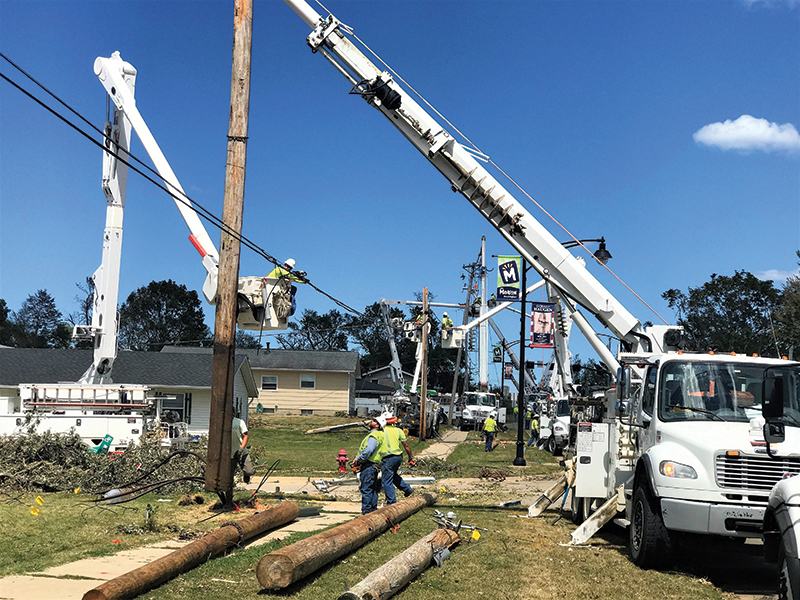Utilities are the disaster response heroes in every community they serve. They quite literally have the power. The power to turn on the lights after a gut-wrenching storm. The power to return their customers’ ability to cook and prepare hot meals for their families.
But this responsibility doesn’t come easily. It often means utility workers report to emergency command centers while their families wait out the storm. It also requires utilities to plan constantly to prepare and then reevaluate their disaster response strategy. But utilities can also learn from each other. Following are two powerful examples – and what we can learn from them.

One town, one unprecedented storm
It’s a warm September day in Fayetteville, N.C. Residents scurry around checking for batteries, flashlights and bottled water. Those living within a mile of the region’s main river, the Cape Fear, are urged to evacuate. Business owners prepare their property for flooding and wind damage. None are certain of exactly what damage the storm will bring, but most are content to over-prepare.
This scenario is not unusual for the military community 60 miles south of the state’s capital, Raleigh. The town is no stranger to adverse weather events. A tropical cyclone makes landfall in North Carolina approximately every two years. More than two storms per year affect the state without making direct landfall.
But this storm, Hurricane Florence, turned out to be different. After crossing the North Carolina coast, the storm hovered for days producing record-breaking rainfall across eastern North Carolina. By the time the hurricane reached Fayetteville, residents were in for four days of unprecedented rainfall. The storm’s persistence made it a new type of menace. By the time the rain stopped, more than $24 billion in damage was done.
“What made Florence such a menace was its longevity,” said Mark Brown, senior customer programs officer, Fayetteville Public Works Commission (PWC). “We had up to 20 inches of rain in certain parts of our area and damage that left more than 50,000 customers without power.”

One Midwest region, one widespread windstorm
It’s another warm, summer day, and Alliant Energy prepares to face a powerful, widespread windstorm. There’s no shortage of severe weather events that cause power outages from intense summer heatwaves and winter storms to tornados and floods. But this windstorm, called a derecho, caused one of the biggest outages in Alliant’s 100+ year history. The massive wind gusts took down trees, ripped apart corn silos and peeled the roof off an apartment complex. The storm passed, but not before it knocked out power for 260,000 people in Iowa. Among the affected areas was Cedar Rapids, Iowa’s second-largest city.
There was no calm after the storm for Alliant. As soon as the dangerous winds passed, their team sprang into action.
“It was all-hands-on-deck to get power restored as quickly as possible,” said Randy Bauer, Alliant Energy’s director of operational resources. “Thankfully, the technology investments we made previously helped provide a roadmap for where we needed to go and what we needed to do.” As the intense winds began to die down, an Alliant team used data from a utility solutions provider’s smart network to execute the outage management and restoration process.
“Data from our system let us know who was with or without power,” said Bauer. “We could also identify transformers that had been damaged, so we knew where to dispatch technicians to make immediate repairs.”
Alliant Energy relied on the near real-time data from their smart utility network to make informed decisions swiftly and restored power for the majority of customers in just a few days. Dedicated crews continued working through the harder-hit areas, and power became available to all customers within 16 days.
What these stories teach us about disaster preparedness
There are three things that these utilities have in common:
- They planned and deployed the right technology. The utility leaders knew it was only a matter of time before the next natural disaster hit. They planned for this unexpected certainty and deployed technology that supported a more efficient disaster response.
- They made data-based decisions. The utilities were nimble after the winds and rains calmed. They acted swiftly and decisively based on the data at their fingertips.
- They helped their communities. Thanks to the forward-thinking individuals and hard-working restoration crews, the communities were able to recover more swiftly after the storm. Preparedness helped the people of these communities.

What we can learn from these utilities
The demand for disaster preparedness is clear, but the path to get there is not. Utilities must ensure investments are sound and technology upgrades scale to meet evolving needs. Following are key technologies you should consider for your disaster response toolkit.
Start with remote management through an Advanced Metering Infrastructure (AMI) system. AMI was the foundation of both Fayetteville and Alliant’s disaster response. Think of it as the railroad tracks for remote management. A smart infrastructure keeps you connected to the information you need before, during and after a storm. It ensures that you can provide the best possible service no matter where you are, or where your customers are. Consider features and software that extend AMI’s benefit to your disaster response plan such as:
- Outage and restoration management: Remote monitoring capabilities automate the outage notification process so crews can be dispatched before the customer calls. This helps save time and costs associated with identifying outages and restoring power for the customer. It also minimizes safety risks to employees investigating the extent of the outage.
- Remote connect/disconnect: Utilities once viewed remote disconnect as a nice-to-have ability in certain service territories. This mindset shifted due to the pandemic as access to customer homes became significantly more challenging. In parallel, some utilities faced smaller work crews because of illness or family issues caused by the pandemic. In either case, remote connect/disconnect empowers utilities to spend more time addressing an outage, and less time at the meter turning service off or on. This is especially beneficial following a natural disaster and widespread outages.
- Customer portals: Provide your customers with a way to check their usage and conserve energy. It is also a disaster preparedness tool to inform customers of their status and provide transparency into the outage restoration process.

Data informs decisions
The right data at the right time means your utility can point crews and resources towards hardest-hit areas first – maximizing the number of customers you can return service to promptly.
Take Fayetteville, for example. The communication network acted as a compass during and after the storm. Their team hunkered down in Fayetteville PWC’s Emergency Response Center when Hurricane Florence arrived. Every department within the utility supported storm response efforts and each employee had an assignment, whether answering phones or updating social media. As the storm slowly made its way through the region, utility staff used their network to stay on top of the situation.
After the storm, the network guided Fayetteville’s crew and the mutual aid workers from Alabama, Georgia and Tennessee that offered additional help with downed powerlines and trees toppled on homes. The utility communicated regularly with emergency responders to help people in need and clear major roads.
“We were able to act quickly because our system let us know exactly where to put boots on the ground,” said Brown. “We had 97% of customers who had lost power back up and running within 96 hours.”
The utility’s efforts to communicate proactively with customers during and after the prolonged hurricane didn’t go unnoticed. Fayetteville PWC was honored with a North Carolina City & County Communicators’ (NC3C) Excellence in Communications Award for their social media communications during the storm. Their social media messages reached nearly half a million people and the team had over 1,300 private message conversations with customers during the storm and the week-long recovery efforts.
Data empowered Alliant’s response to the derecho as well. They put their technology to work for meter mapping to prepare for the next adverse event.
The utility was using geographic information system (GIS) mapping to help understand the topography of their service area, but they found inconsistency in the data. “Maps can get messy when you’re focused on getting the lights back on quickly for so many customers,” said Bauer. “The only thing you can be sure of with GIS mapping is that it’s going to get out of date really fast.”
This led them to conduct a pilot program with the phase detection across 600 electricity meters in the town of DeWitt, Iowa. This extension of the utility’s smart network proved capable of detecting the correct phase with 100% accuracy.
“We went out and field-verified those results, and it turned out we had 240 mismatched meters,” said Bauer. “Resolving these types of inaccuracies moving forward will help us serve our customers better.”
The Alliant team was so impressed with the results of the pilot program that they plan to extend the capability across their entire service area.
Essential services for the community
Natural disasters don’t wait for you to be prepared. In fact, these tragedies are on the rise due to climate change, their impact intensified by pressures like population growth and coastal development. The 2020 Atlantic hurricane season is historical for several reasons. According to the National Oceanic and Atmospheric Administration, this past season included:
- A record-breaking 30 named storms – the most storms on record
- 12 storms that made landfall in the continental United States
- Six major hurricanes
This data only accounts for one type of natural disaster. Wildfires, flooding and drought impact communities every single year.
Don’t let these numbers intimidate you. Utilities are uniquely positioned to help their communities weather the storm. Plan, deploy smart technology and follow the lead of community-focused utilities like Alliant Energy and Fayetteville PWC. Utilities have the power to restore service, save lives and support their communities no matter what lies ahead.
 Mike McGann is vice president of Sensus Americas, Global Engineering and Assessment Services at Xylem. He leads teams solving tomorrow’s biggest challenges for water, gas and electric utilities, today.
Mike McGann is vice president of Sensus Americas, Global Engineering and Assessment Services at Xylem. He leads teams solving tomorrow’s biggest challenges for water, gas and electric utilities, today.
As a Lean Six Sigma Master Black Belt and a United States Marine Corps Veteran, he is skilled in applying continuous improvement methodology and process control to help individuals and teams do their best work and serve their customers and communities.






